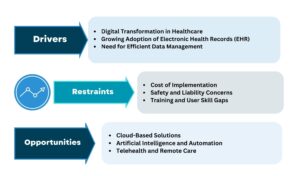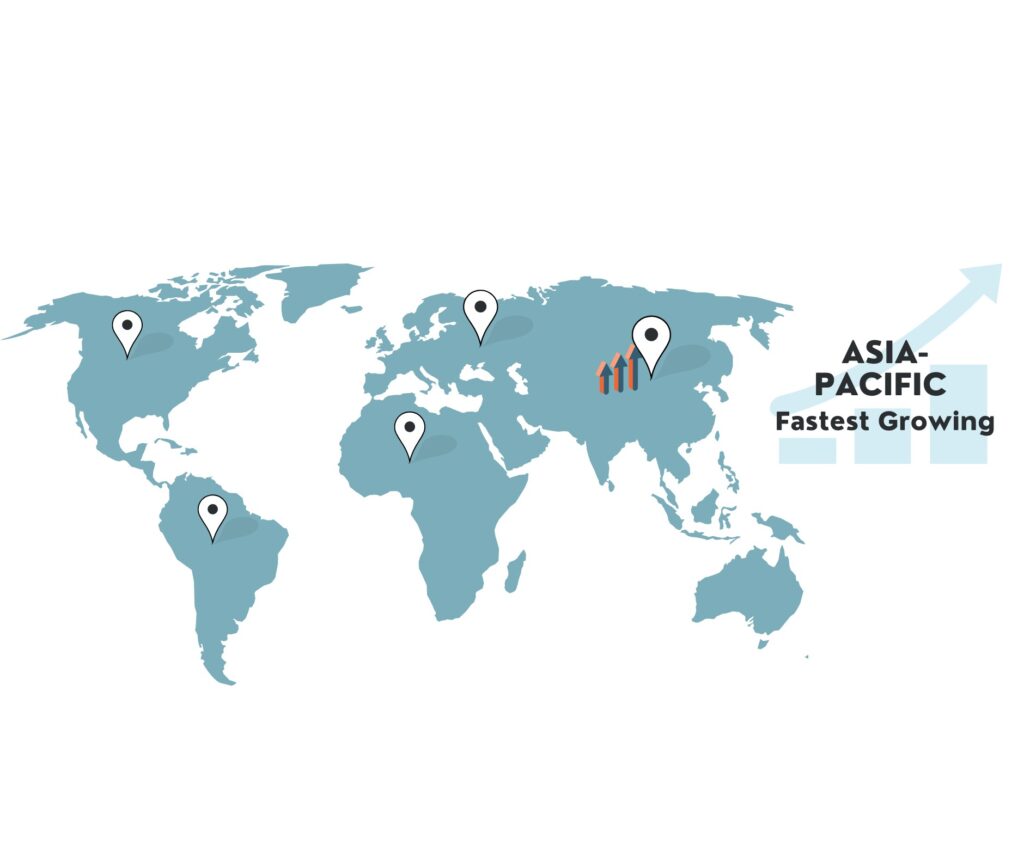Description
The Global Healthcare Document Management Systems Market size was USD 1.54 billion in 2022 and it is expected to grow to USD 3.04 billion in 2030 with a CAGR of 10.68% in the 2023-2030 period.
Global Healthcare Document Management Systems Market: Overview
Global Healthcare Document Management Systems (DMS) market was experiencing steady growth due to the increasing adoption of electronic health records (EHR) and the need for efficient data management in the healthcare industry. Healthcare Document Management Systems are software solutions designed to store, manage, and organize medical records, patient information, and other healthcare-related documents in a digital format. Healthcare organizations worldwide were transitioning from paper-based systems to electronic document management systems, seeking improved efficiency, accessibility, and security of medical records. Many countries were implementing regulations and guidelines encouraging the adoption of electronic health records and document management systems to enhance patient care, reduce medical errors, and improve data interoperability. The healthcare industry generates vast amounts of data daily. Document management systems help in handling this large volume of data, making it easier for healthcare providers to access and retrieve patient information when needed. Healthcare document management systems streamline administrative processes, reduce paperwork, and enhance collaboration among healthcare professionals, ultimately leading to improved patient care. Integration capabilities with Electronic Health Records (EHR) systems, Picture Archiving and Communication Systems (PACS), and other healthcare software contribute to the market’s growth, as it facilitates seamless data exchange and interoperability.
Global Healthcare Document Management Systems Market: Covid-19 Impact
The pandemic underscored the importance of digitization in healthcare. To minimize physical contact and maintain operational continuity during lockdowns and social distancing measures, healthcare providers may have expedited their adoption of document management systems to enable remote access to patient records and streamline administrative processes. The surge in telehealth and remote consultations during the pandemic necessitated robust document management systems to handle digital patient data securely. This demand likely prompted healthcare organizations to invest in better IT infrastructure and document management solutions. The pandemic disrupted global supply chains, impacting the manufacturing and distribution of healthcare IT solutions. This could have affected the availability and delivery of document management systems to healthcare providers. Healthcare organizations faced financial challenges during the pandemic due to increased expenses and revenue losses. As a result, some may have reconsidered their investment in non-essential projects, which could have impacted the adoption of new document management systems. Governments worldwide might have introduced new policies and initiatives to support digital healthcare and the adoption of healthcare IT solutions. These regulations could have influenced the adoption of document management systems in the healthcare sector.
Global Healthcare Document Management Systems Market: Growth Drivers

-
Digital Transformation in Healthcare:
Healthcare organizations were increasingly adopting digital technologies to improve operational efficiency and patient care. Document management systems played a crucial role in this transformation by enabling the transition from paper-based to electronic document management, streamlining workflows, and reducing manual paperwork.
-
Growing Adoption of Electronic Health Records (EHR):
The widespread adoption of electronic health records in healthcare facilities led to a higher demand for integrated document management systems. Healthcare providers sought efficient ways to manage and organize the vast amount of digital patient information generated by EHR systems.
-
Need for Efficient Data Management:
The healthcare industry generates a massive volume of patient data, including medical records, test results, and imaging reports. Document management systems provided a structured and centralized approach to store, manage, and retrieve this data, making it easily accessible to authorized healthcare professionals.
-
Improved Patient Care and Safety:
Document management systems allowed healthcare providers to access patient information quickly and accurately, leading to improved decision-making and better patient outcomes. The availability of real-time data helped healthcare professionals make more informed clinical decisions.
Global Healthcare Document Management Systems Market: Restraining factors
-
Cost of Implementation:
The initial cost of implementing a healthcare document management system, including software, hardware, and training, could be a significant barrier for some healthcare organizations, particularly smaller healthcare facilities with limited budgets.
-
Safety and Liability Concerns:
Healthcare companion robots operate in sensitive environments and interact with patients. Concerns related to safety, data privacy, and liability may arise if the robots malfunction or make errors that result in harm to patients.
-
Training and User Skill Gaps:
Implementing a new document management system requires adequate training for healthcare staff to ensure effective utilization. If proper training is lacking, it can lead to underutilization of the system and hinder its potential benefits.
Global Healthcare Document Management Systems Market: Opportunity factors
-
Cloud-Based Solutions:
The adoption of cloud-based document management systems offered significant advantages, such as scalability, cost-effectiveness, and remote accessibility. Cloud solutions provided healthcare organizations with the opportunity to store and manage patient data securely without investing in extensive IT infrastructure.
-
Artificial Intelligence and Automation:
Integrating artificial intelligence (AI) and automation into document management systems presented opportunities to enhance data processing, improve accuracy, and automate routine tasks. AI-powered systems could extract relevant information from unstructured data, such as medical reports and notes, saving time and improving decision-making.
-
Telehealth and Remote Care:
The rise of telehealth and remote patient care during the COVID-19 pandemic created opportunities for document management systems to support virtual consultations. DMS facilitated secure sharing of medical records and test results between healthcare providers and patients, improving the efficiency of remote care delivery.
-
Global Health Information Exchange:
As healthcare becomes increasingly interconnected, there was an opportunity for document management systems to contribute to global health information exchange networks. Seamless data sharing between countries and regions could improve the continuity of care for patients with a history of international healthcare interactions.
Global Healthcare Document Management Systems Market: Challenges
-
Data Security and Privacy Concerns:
Healthcare data is highly sensitive and subject to strict privacy regulations. Ensuring the security and privacy of patient information within document management systems was a significant challenge, as any breaches or unauthorized access could have severe consequences.
-
Integration with Legacy Systems:
Many healthcare organizations still relied on legacy systems and paper-based processes. Integrating modern document management systems with legacy systems could be difficult, leading to potential inefficiencies and resistance to change.
-
Cost and Financial Constraints:
Implementing and maintaining document management systems involved considerable costs, especially for smaller healthcare facilities with limited financial resources. The initial investment and ongoing expenses could be challenging to manage for some organizations.
-
Regulatory Compliance:
Healthcare document management systems must comply with various industry regulations and standards, such as HIPAA (Health Insurance Portability and Accountability Act) in the United States. Ensuring adherence to these regulations added complexity to the development and implementation process.
Global Healthcare Document Management Systems Market: Segmentation
- Based On Product Type: The market is segmented into Services and Solutions depending on the type segmentation. Among these solutions segment dominates the market share due to increasing demand for integrated and comprehensive document management solutions that can help healthcare organizations improve their efficiency, productivity, and compliance.
- Based On Application: Based on application segmentation, the market is further divided into Medical Records, Billing Records, Admission and Registration. Among these, the Medical Records segments contributes a significant revenue to the market. Due to its increasing demand for electronic medical records (EMRs) and the need to store and manage these records securely.
- Based On Region: Based on Region, the market is segmented into five key geographical regions namely – North America, Europe, Asia Pacific, Latin America, and Middle East & Africa.
Global Healthcare Document Management Systems Market: Regional Insights

North America, especially the United States, held a significant share of the global healthcare DMS market. The region’s early adoption of electronic health records (EHR) and other healthcare IT solutions drove the demand for integrated document management systems. Favorable government initiatives and regulations promoting the use of EHR and technology in healthcare further contributed to market growth. The presence of well-established healthcare facilities and a focus on providing high-quality patient care fuelled the demand for efficient data management solutions like document management systems. European countries, such as the United Kingdom, Germany, and France, had strong healthcare systems with an emphasis on digitization and interoperability. Government support for electronic health records and investments in healthcare IT infrastructure created opportunities for document management systems vendors. European healthcare organizations sought solutions that complied with stringent data protection regulations, such as the General Data Protection Regulation (GDPR), driving the need for secure document management systems. The Asia-Pacific region represented a rapidly growing market for healthcare document management systems due to the increasing adoption of technology in the healthcare sector. Rising healthcare expenditures, growing awareness of the benefits of electronic health records, and a push towards digitization in emerging economies like China and India contributed to market growth. Cloud-based document management solutions gained popularity in the region, offering scalability and cost-effectiveness for healthcare providers. Latin America saw a growing interest in healthcare IT solutions, including document management systems, to enhance healthcare delivery and data management. Government initiatives to improve healthcare infrastructure and access to healthcare services supported the adoption of technology solutions in the region. Challenges related to infrastructure and data security remained factors influencing market growth. The Middle East and Africa region had varying levels of healthcare technology adoption. Some countries in the region showed a growing interest in digitization and healthcare IT solutions. Limited IT infrastructure and resources in certain areas acted as barriers to the widespread adoption of document management systems. Efforts by governments and healthcare organizations to modernize healthcare systems drove the demand for technology solutions, including document management systems.
Global Healthcare Document Management Systems Market: Competitive Analysis
The Global Healthcare Document Management Systems Market is driven by various key players such as Nextgen Healthcare Information Systems LLC, Canon Medical Systems, Seimens Healthineers, McKesson Corporation, EPIC System Corporation, Kofax Inc, Veradigm, Hyland Software Inc, Cerner Corporation, and Athena Health Inc.
Global Healthcare Document Management Systems Market: Recent Developments
- Nextgen Healthcare Information Systems LLC: On July 13, 2023, NextGen Healthcare expanded its alliance with the American Podiatric Medical Association (APMA). The alliance will provide APMA members with exclusive content and blueprints to improve care. NextGen will also provide APMA members with access to its cloud-based EHR and practice management software.


